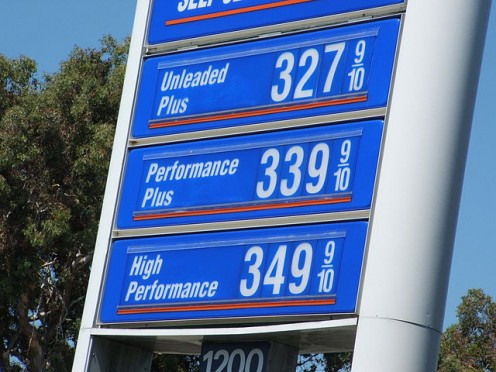One-Tenth a Cent Less Per Gallon of Gas-- Or Nine-Tenths More?

The Little Things
If it is true that it's the little things in life that count, then it follows that it's the little things that can drive you mad. There are so many problems facing us though, so many terrible wrongs, so much inequality and corruption at every level of society, that fretting about the small stuff might seem petty. So, call me petty, because I'm bugged about a tenth of a cent-- specifically, the tenth part of a penny we “save” on a gallon of gas. When the price of gas is $3.29 9/10, many people apparently see $3.29 and a few even see $3.20. And that's what the oil companies want you to see. I see $3.30, but, then again, I pay off my credit card in full every month, so I'm obviously a trouble-maker. Actually, it's not the tenth of a cent that sets me off, it's the nearly invisible nine-tenths of a penny and the attitude behind it: you are dumb sheep that are easily manipulated by corporate madmen. It's the same thing as car prices set at $19,999 (“Wow! That car costs less than $20 Grand!”), except they've had to invent a fictitious denomination. There is actually a marketing science called “nine dollar endings” to apply this subconscious yearning to drop the “nine” instead of rounding. And, while you might think, “at least I'm saving a tenth of a cent”, you are, in fact, paying an extra nine-tenths of a cent. It's all been factored in; that partial cent accounted for an extra $1,280,000,000 in 2007.

Why?
No one, not even the head of the Petroleum Marketers Association of America, seems to know for certain when, or why this weird pricing started, although it's been in use since at least the 1920s. Of course, back then, a tenth of a cent was worth a lot more than today, so that probably had something to do with it. Then there's federal and state taxes, which, though they started in cents, later fell victim to the same “tenths of cents” adjustments. Some have speculated that this is where the partial cents originated, but, again, no one seems to know. In any case, nowadays you rarely see gas prices ending in anything but “9/10” and on signs where the dollars and cents are replaceable, it's likely the “9/10” is permanently affixed. Then there's the view that it's tradition and everyone does it. Well, yes, it's been going on for 90-plus years, but when have corporations clung to tradition over profits? It's not tradition. The consensus about why it's still going on is simple: marketing and sheep (okay, I slipped the sheep part in).
An Inconvenient Fact
Then there is this inconvenient fact: you cannot buy a gallon of gasoline for the advertised price. When you purchase a single gallon, you are charged $3.30 even though the sign says 329.9 cents. This led the late Iowa state Senator Joe Coleman in 1985 to sponsor a bill to outlaw the nine-tenths pricing and the great state of Iowa passed it, becoming the only state in the union where cents ruled (sorry). Unfortunately, four years later state Senator Michael Gronstal, circumventing any debate, tacked an amendment repealing the ban on another bill and the fictitious partial penny snuck back into that fair green land. Other than Gronstal saying that Coleman had a meaningless pet peeve about so-called “deceptive pricing”, the reason for going to the bother of sneaking in the amendment to rescind it remains a mystery.
A Ray of Hope?
So the nine-tenths is with us still and will stay as long as it only bugs those of us with pet peeves and visions of madmen and sheep. There is one ray of hope. Back in 2006, Jim Davis, in Palo Alto, California, dropped the fractional penny and rounded down to the nearest cent. When a newspaper ran a story about it, his business picked up and he's been doing it ever since, proudly displaying “No 9/10” signs on his pumps. It's not exactly spreading like wildfire. Maybe it would be easier working towards world peace.






